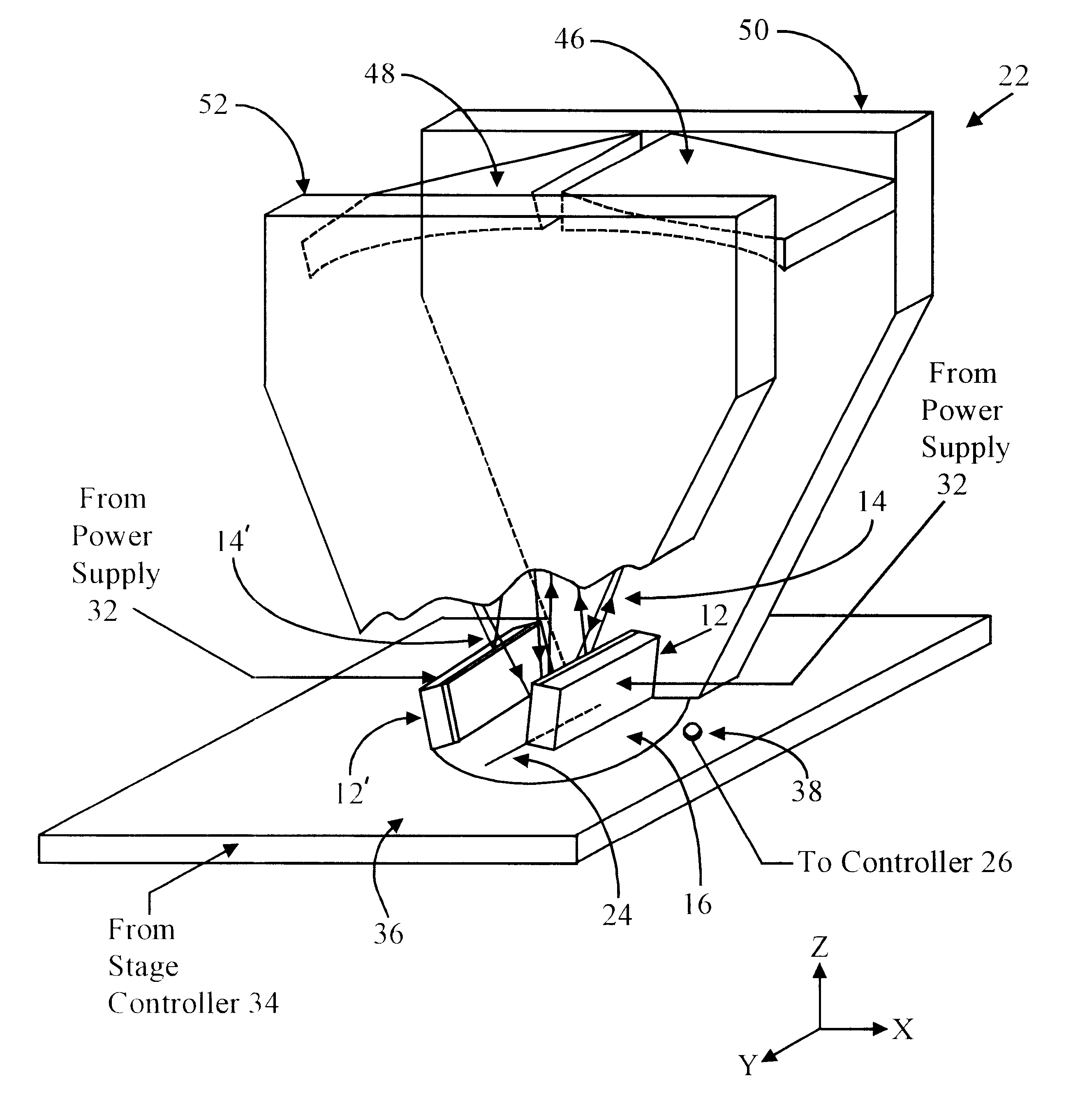Apparatus having line source of radiant energy for exposing a substrate
a radiant energy and apparatus technology, applied in the direction of photomechanical apparatus, instruments, manufacturing tools, etc., can solve the problems of expensive lasers, difficult to achieve good dose uniformity over a relatively large area in a single, and large area
- Summary
- Abstract
- Description
- Claims
- Application Information
AI Technical Summary
Benefits of technology
Problems solved by technology
Method used
Image
Examples
first embodiment
In FIG. 1, an apparatus 10 in accordance with this invention is shown. The apparatus 10 includes a line source 12 that generates relatively intense radiant energy 14 used for treatment of a substrate 16. The line source 12 includes one or more laser diode arrays each having a plurality of laser diodes 18 positioned at regular spaced intervals along a linear emission face 20 thereof. The laser diodes 18 are relatively closely-spaced and positioned at intervals along a linear direction defining the axis of the laser diode array. The line source 12 can generate radiant energy 14 at a wavelength from about 350 nanometers (nm) to 950 nm. Such wavelength range is particularly effective for processing the substrate 16 if such substrate is composed of silicon and the integrated device or circuit features are on the order of one micron or less with source / drain regions of a few. tens of nanometers (nm). in thickness. However, the invented apparatus is not limited to a line source 12 that gen...
second embodiment
In FIG. 6, the apparatus 10 is shown. The apparatus 10 includes an additional line source 12' that can include laser diode array(s). Like the line source 12, the line source 12' is coupled to receive current from the power supply 32. Based on the current, the line source 12' generates radiant energy 14'. The relay 22 includes elliptical or spherical mirrors 46, 48, and planar side wall mirrors 50, 52. The line source 12 is arranged to direct radiant energy 14 to the mirror 46, which reflects such radiant energy to the line image 24. Similarly, the line source 12' is arranged to direct radiant energy 14' to the mirror 48, which also reflects such radiant energy to the line image 24. The relay 22 images the line sources 12, 12' to the same position or adjacent positions to form the line image 24. The side wall mirrors 50, 52 are positioned on opposite sides of the mirrors 46, 48 and are preferably spaced apart a distance equal to the length. of the line image 24. The mirrors 50, 52 re...
sixth embodiment
In FIG. 11, the optical relay 22 in the apparatus 10 is catoptric, i.e., all-reflective, non-refractive. The optical relay 22 of FIG. 11 includes a mirror 104 with a base 106 defining intersecting planar reflective surfaces 108, 110. The base 106 includes a rigid material such as glass or plastic, that defines the surfaces 108, 110. The surfaces 108, 110 are made reflective by deposition of reflective material(s) such as aluminum or alternating dielectric layers of different refractive indices on such surfaces. The line source 12 is arranged to direct radiant energy 14 to the reflective surface 108, and the line source 12' is arranged to direct radiant energy 14' to the reflective surface 110. The radiant energy 14, 14' reflected from respective surfaces 108, 110 travels to respective portions of the reflective surface of the curved mirror 111. The radiant energy 14, 14' reflected from the mirror 111 travels to the substrate 16 to form the image 24 thereon. As shown in FIG. 11, the ...
PUM
| Property | Measurement | Unit |
|---|---|---|
| wavelength | aaaaa | aaaaa |
| wavelength range | aaaaa | aaaaa |
| wavelengths | aaaaa | aaaaa |
Abstract
Description
Claims
Application Information
 Login to View More
Login to View More - R&D
- Intellectual Property
- Life Sciences
- Materials
- Tech Scout
- Unparalleled Data Quality
- Higher Quality Content
- 60% Fewer Hallucinations
Browse by: Latest US Patents, China's latest patents, Technical Efficacy Thesaurus, Application Domain, Technology Topic, Popular Technical Reports.
© 2025 PatSnap. All rights reserved.Legal|Privacy policy|Modern Slavery Act Transparency Statement|Sitemap|About US| Contact US: help@patsnap.com



